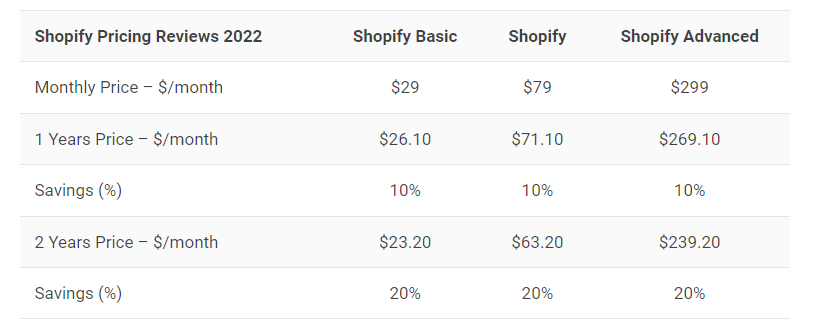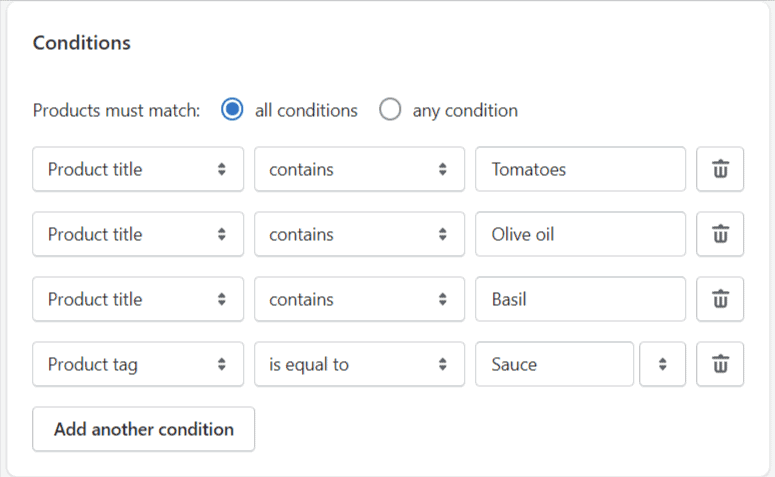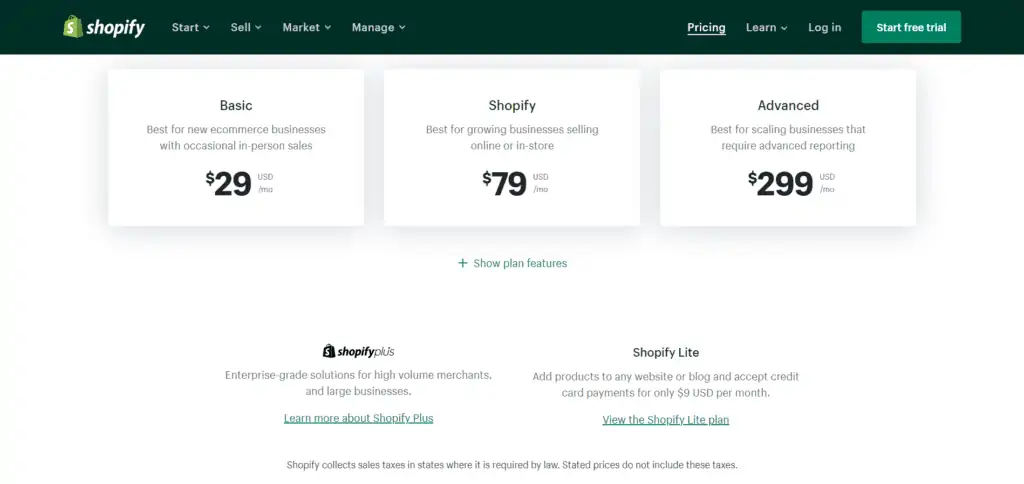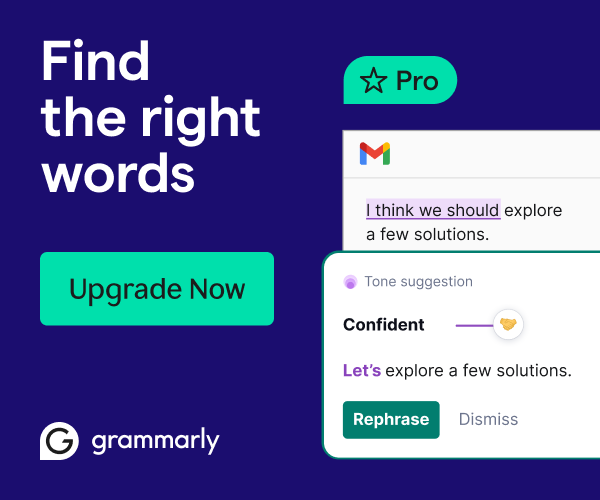

Heads up: Our content is reader-supported. This page includes affiliate links. If you click and purchase, I may receive a small commission at no extra cost to you.
About Shopify
Shopify is an all-in-one commercial solution that requires no technological expertise, design experience, or investment. It lets anybody construct a profitable online business.
The platform provides over 100 optimized templates for your website, accepts online payments (with credit cards, Paypal, etc.), and interacts with third-party applications so you may expand your toolset without slowing down your website.
Shopify’s Storefront Renderer architecture boosts site performance, making it x2.97 faster than average. It offers built-in SEO capabilities to improve your website. Registering on Shopify’s website, completing a quick setup procedure, and personalizing it with its straightforward interface is easy.
Who Should Use Shopify?
Shopify is a reliable platform that is designed to be used by anybody. It distinguishes out due to its versatility and user-friendliness, among other things.
Shopify can accommodate practically any company because to its simple usage, reasonable cost, third-party integration, offline support, and scalability. Shopify is recommended for:
- great loading and speed
- launching your company in a single afternoon
- integrating applications from other parties
- amazing design
- Including Amazon
- Integrated POS for retail
- SEO capabilities
- Features for social selling including Facebook Shop, Buyable Pins, and Facebook Messenger
Is It Right for Beginners?
- To launch a website, you don’t need to pay for a domain or web hosting. Without your knowledge, Shopify offers all of a website’s essential features.
- You don’t have to start from scratch when designing your website and consider how it ought to appear. One of the easiest online shop builders available is provided by Shopify.
- It is unnecessary to worry about code, theme, or feature optimization for your website. Since they were all designed from the ground up to be optimized for both speed and SEO.
- Finding a third-party payment processor is not necessary. Customers may currently use Shopify’s payment platform to make credit card and Paypal payments.
- Setting up a few rules makes managing your product catalogues really simple. They’ll automatically arrange.
- Shopify is specifically designed for beginners without any technological knowledge. And the platform’s design demonstrates that, since the custom reporting and analytics are undoubtedly its most sophisticated capabilities.
Shopify Pricing
Given that they are created for various market sectors and firm sizes, the differences between these price plans are fairly significant.
The price of utilizing Shopify, however, is not solely dependent on the plan you choose. You’re probably going to require premium themes, features, and third-party applications to maintain the effectiveness of your shop.
A premium theme, for instance, may cost between $140 and $200. The store’s premium plugins might increase the monthly fee from $10 to $30. Furthermore, Shopify’s payment processing costs.
Therefore, it is important to check on the extra features you’ll need to operate your e-commerce effectively if you’re seeking to build up a budget for it.

What’s the Best Shopify Plan?
The fundamental $29/month plan is the greatest choice as a place to start since it includes everything you need to set up a fully working online business. Naturally, when your firm expands, you’ll update your plan.
However, if you have the necessary skills and are developing a particularly particular kind of company Then you’d be more inclined to choose a more complex strategy right away in order to expand quicker.
The 14-Day Free Trial
The 14-day free trial that Shopify gives you access to all functionalities. In this approach, you may completely evaluate the platform without being obligated and determine whether it’s a good match for you.
Even better, you may register for a trial account only to experiment with the platform and delete it once you’ve made up your mind.
Shopify Lite
if you already run a blog or website. For $9 per month, the light plan enables you to use a product catalogue.
You may integrate a light POS software for offline sales together with credit card acceptance. As many goods as you need may be added.
It works with any platform where you host your online presence, including WordPress, Squarespace, Tumblr, and others.
Shopify Basic
The best recommendation for anybody looking to open a new online business is this choice. It will have the fundamental capabilities needed to host your website under a unique domain name, process payments, and manage the technical aspects of your shop.
- The online shop module for Shopify.
- the offline sales Point of Sale (POS) system.
- You may immediately sell on Facebook and Pinterest thanks to the Facebook and Pinterest modules.
- Support for several languages and currencies.
- help for shipping.
- countless goods
- marketplaces and social media sales platforms.
Shopify Standard
The standard plan includes more features than the basic plan, which will help you run your company more effectively. enabling you to use features like:
- Standard analytics reports help monitor your company’s effectiveness, areas for progress, and weak spots.
- a cheaper Shopify payment processing cost.
- price and the capacity to add foreign domains.
- The size of your team will expand as the number of employees rises.
- reductions on shipping up to 88%.
Advanced Shopify
The costliest package, which costs $299 per month, has more tools that will help you build and scale your organization. For instance:
- You’ll have access to the tool for creating custom reports. It includes sophisticated tools to gather more information, monitor fine-grained metrics, and provide insights that might help you expand your company forever.
- includes sophisticated reports to optimize your shop, segment your consumer base, and assign money to your sales channels.
- comes with more precise shipping prices that were computed by a third source. So that you may provide additional shipping alternatives and be more upfront with your consumers about shipping prices (standard, express, and one-day).
- 15 staff member accounts maximum to administer your company. It is enough for creating a respectable-sized business.
Shopify Support System
You always need strong help to get unstuck, even if Shopify is the most user-friendly platform on the market.
The good news is that all users from all plans get the same level of assistance. The same support resources are available to them all and are as follows:
- For quick assistance, there is 24-hour phone support.
- Live chat is available around-the-clock for rapid answers.
- Email and social media for requests and information
Shopify’s Web Security and Backups
With Shopify, you won’t have to worry about updating your website, platforms, and applications or putting in place complex security measures. Shopify will take care of everything.
The solution includes coverage for even unnoticed elements like credit card information, scams, or privacy settings.
In order to protect your account from unauthorized logins, Shopify now offers two-factor authentication (2FA), which is strongly advised to use.
App Store and Third-Party Integrations
Shopify’s built-in features are limited. Because of this, there’s an official app store where you may install one of 4,000 third-party apps.
- 80% of Shopify merchants have installed at least one third-party app, depending on their company.
- Klaviyo sends emails, creates automatic flows and autoresponders, sends marketing campaigns, and segments your audience.
- Shoelace and other remarketing software develop retargeting advertisements to boost sales.
- CRM to manage customers and sales teams.
- Social selling applications sell on Facebook and Instagram.
People select Shopify because of its app store. Because there are so many alternatives.
Managing Product Categories and Collections
Once you upload several items, you should organize and classify them to save time (and complete the buying process as smoothly as possible).
On Shopify, you can build product “collections” Click “Collections” and “add new.”
Then write the collection’s title, description, and picture.
Adding goods to collections is automatic; you just need to set criteria. I may add sauce components by adding items with “tomatoes,” “olive oil,” or “basil” in the title (or tagging them as “sauce”).


Shopify Shipping Aspects
for sending products. There is a service called “Shopify Shipping” that enables you to:
- Create flat prices, price-based rates, weight-based charges, free shipping rates, and more.
- Give prices for local delivery and pickup.
- Offer shipping estimates from neighbourhood postal agencies in real time (UPS, USPS, DHL Express, Canada Post, Sendle, and Hermes)
- Make shipment labels.
- Offer discounted shipping prices.
As long as you are headquartered in North America, Australia, or the United Kingdom, Shopify Shipping is available to you. Otherwise, you’d need to upgrade to the “Shopify Plus” plan or higher, pay an extra monthly price, and pay your plan yearly.
Setting up Your Payments
- The moment your Shopify shop is operational, it will be automatically configured to take all major credit cards.
- Depending on your Shopify plan, choose your card rate. Anytime you want, you may alter.
- From the Shopify admin, you can keep track of your payment schedule and pending payout amount.
- Since payments are connected to the orders they are associated with, you can see how much you will get for each order or charge in payment fees.
- Utilizing the chargeback replies generated by Shopify for all impacted purchases, quickly recoup lost revenues due to chargebacks.
- You won’t pay extra transaction costs beyond the card rate, depending on where you are. These nations include Australia, the United States, Canada, and the United Kingdom.
Third-Party Payment Provider for Credit Cards
If you’re not utilizing Shopify Payments, you may use one of 100 third-party payment providers.
Use Shopify Payments, POS, or manual payments to avoid transaction costs. The costs vary from 2.9%+30 USD to 2.4%+30 USD.
Shopify supports two credit card payment providers:
Suppliers
Providers external.
Customers may finish their purchases on your online shop if you choose a direct supplier. If you use an external supplier, your consumers must finish their transactions on an outside checkout page, which is riskier and less convenient.
Shopify POS
If you have a brick-and-mortar business and want to link it to your online presence, Shopify’s Point of Sale (POS) software is particularly helpful since it enables you to accept payments offline and in person.
Your orders and stock are synced across the Shopify POS app and all offline and online channels. Moreover, it enables you to use the app to manage your orders.
The POS app is supported by all plans, so you don’t need to worry about upgrading to use it. It is open to all Shopify users.
Is PayPal accepted by Shopify?
Yes. PayPal has an easy-to-use integration with Shopify. You’ll get a PayPal Express Checkout account as soon as your shop is up and running, and you’ll get an email telling you that you need to create a PayPal business account in order to access the funds.
What Payment Methods Are Manual?
There are various non-automatic payment option. Shopify lets you manually handle sales by emailing an invoice and marking an order as paid. No transaction fees are charged.
This includes:
- Cash on delivery (COD)
- custom
- Loans
- Gift card money order store credit
Calculate Taxes Automatically
Depending on your area, you must add tax. Shopify handles sales tax computations and may configure tax overrides.
Shopify updates the default tax rates for countries like the U.S. You should verify that the current rate applies to you.
Examples of Shopify-powered online shops
Tattly
Tattly was created by a woman weary of purchasing her daughter cheap, bad-looking temporary tattoos. She hired designers to build her own tattoo brand and sell it online.
Graydon
Graydon is a vegan skincare shop started by a vegan chef.
The website is well-designed. It has a blog, pages, and sections. Its expansion is obvious.
Allbirds
Tim Brown, from New Zealand, established Allbirds on Shopify.
Tim began utilizing merino wool, a sustainable material the footwear business wasn’t employing. So he worked with Zoey Zwillinger to produce eco-friendly shoes.
Advantages
- When building an ecommerce site, you need speed and security, two advantages that come with premium hosting packages. Shopify ensures sure your clients don’t leave for a competitor’s site due to slow load times.
- Shopify handles sensitive data and payments securely.
- Shopify is all about design, and there are lots of free and paid themes to make your site appear professional and visually beautiful.
- Shopify is user-friendly for beginners. If this is your first time utilizing this platform, you shouldn’t have any concerns.
- Shopify provides a wide choice of themes, so you’ll find one you like.
- Shopify has lower monthly rates than WordPress.
- You may extend the feature set using plugins from the app store. There’s a third-party app for practically anything, so you probably don’t need a coder.
Disadvantages
- Shopify’s monthly membership, premium themes, applications, and transaction processing fees (if you don’t use Shopify Payments) cost money. You must consider them while comparing store-starting products, particularly if you want to sell in bulk.
- Sometimes Shopify’s tech support puts you on a 30-minute wait, which isn’t helpful if you prefer speedy answers.
- Shopify can perform almost everything out of the box, however the backend has proprietary code. This means you need someone who understands their stuff and has time to learn Shopify. This increases maintenance expenses and slows shop management.
FAQ’s
Shopify dropshipping?
Yes, AliExpress and Oberlo are dropshipping applications. Shopify is ideal for dropshippers. You simply need to go to the app store and search for your preferred dropshipping app, and Shopify will take care of synchronizing everything.
Shopify hosting?
Shopify’s cloud-hosted e-commerce platform includes web hosting. Everything is managed in one location, so you don’t require an additional web server.
Shopify’s server is optimized for ecommerce, so you know you’re receiving the best.
Shopify allows digital sales.
Yes, and the “Downloadable digital materials” app is free.







